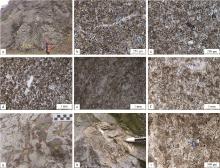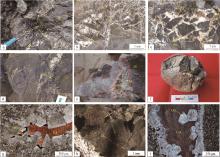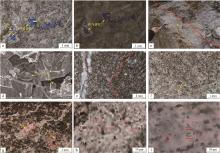

石油与天然气地质 ›› 2021, Vol. 42 ›› Issue (3): 639-651.doi: 10.11743/ogg20210310
黎霆1,2( ), 诸丹诚1,2, 杨明磊1,2, 李平平1,2, 邹华耀1,2,*(
), 诸丹诚1,2, 杨明磊1,2, 李平平1,2, 邹华耀1,2,*( )
)
收稿日期:2020-12-30
出版日期:2021-06-28
发布日期:2021-06-23
通讯作者:
邹华耀
E-mail:cuperliting@163.com;huayaozou@cup.edu.cn
第一作者简介:黎霆(1995—),男,博士研究生,碳酸盐岩储层。E-mail: 基金项目:
Ting Li1,2( ), Dancheng Zhu1,2, Minglei Yang1,2, Pingping Li1,2, Huayao Zou1,2,*(
), Dancheng Zhu1,2, Minglei Yang1,2, Pingping Li1,2, Huayao Zou1,2,*( )
)
Received:2020-12-30
Online:2021-06-28
Published:2021-06-23
Contact:
Huayao Zou
E-mail:cuperliting@163.com;huayaozou@cup.edu.cn
摘要:
二叠系茅口组热液白云岩储层是近几年四川盆地勘探的热点领域,受到峨眉山玄武岩喷发的影响,热液活动在茅口组白云岩中十分普遍,但对于热液如何影响白云岩储层还缺乏系统的认识。基于野外观测、岩心和岩石薄片观察、阴极发光、包裹体均一温度和地球化学分析,取得了以下几点认识。①根据宏观产状,茅口组白云岩可分为层状白云岩和斑块状白云岩,层状白云岩是主要的类型。根据微观结构,层状白云岩可进一步分为粉-细晶白云岩和细-中晶白云岩,斑块状白云岩则由中-粗晶白云石组成。②细-中晶白云岩多呈斑块状分布在粉-细晶白云岩中,具明显的不等晶结构,且发育与热液相关的构造和矿物,与粉-细晶白云岩相比,细-中晶白云岩具有较高Fe和Mn含量、较强的阴极发光、较高的包裹体均一温度、偏负的δ18O(PDB)值及较高的87Sr/86Sr值,表明细-中晶白云岩是粉-细晶白云岩在热液作用下重结晶形成。③热液对茅口组白云岩储层的建设性作用表现在热液活动形成裂缝系统和角砾,热液溶蚀形成溶蚀孔洞,热液交代原始灰岩形成白云岩;破坏性作用表现在热液矿物沉淀充填先前孔、缝、洞和热液重结晶,重结晶过程有新的Mg2+和CO32-加入,导致重结晶后白云岩物性变差。④茅口组储层储集空间形成的主要驱动力是早期大气淡水溶蚀,热液可以作为储层发育的一个潜在信号,因此针对茅口组储层,应以滩控早期岩溶为核心思路进行勘探。
中图分类号:
表1
四川盆地茅口组灰岩与不同类型白云岩碳氧同位素、锶同位素和铁、锰含量统计"
| 样品来源 | 岩性 | 层位 | 宏观产状 | 微观结构 | 晶体形态 | 晶体分布 | δ18O(PDB)/‰ | δ13C(PDB)/‰ | 87Sr/86Sr | Fe/10-6 | Mn/10-6 |
| 丰都放牛坝剖面 | 白云岩 | 茅三段 | 层状 | 粉-细晶 | 自形 | 单峰 | -3.3 | 4.3 | 0.707 701 | 268.1 | 22.0 |
| 白云岩 | 茅三段 | 层状 | 粉-细晶 | 自形 | 单峰 | -4.2 | 4.1 | 0.707 823 | 382.8 | 36.1 | |
| 白云岩 | 茅三段 | 层状 | 中晶 | 它形 | 单峰 | -7.2 | 3.4 | 0.707 935 | 1 243.8 | 69.9 | |
| 白云岩 | 茅三段 | 胶结物 | 鞍状晶 | 它形 | — | -10.9 | 4.0 | 0.710 186 | 1 145.4 | 127.6 | |
| 白云岩 | 茅三段 | 斑块状 | 中-粗晶 | 半自形 | 多峰 | -9.3 | 4.2 | 0.709 122 | 2 235.7 | 98.9 | |
| 泥晶灰岩 | 茅三段 | — | — | — | — | -4.6 | 3.8 | 0.707 384 | 135.0 | 21.0 | |
| 华蓥二崖剖面 | 白云岩 | 茅二段 | 层状 | 细-中晶 | 半自形-自形 | 多峰 | -7.2 | 3.2 | 0.707 975 | 861.7 | 59.6 |
| 白云岩 | 茅二段 | 层状 | 细-中晶 | 半自形-自形 | 多峰 | -6.8 | 3.8 | 0.707 838 | 457.1 | 49.1 | |
| 白云岩 | 茅二段 | 斑块状 | 中-粗晶 | 它形 | 单峰 | -11.6 | 3.3 | 0.709 328 | 1 971.4 | 180.0 | |
| 白云岩 | 茅二段 | 胶结物 | 鞍状晶 | 它形 | — | -11.4 | 3.9 | 0.709 595 | 1 006.0 | 180.1 | |
| 泥晶灰岩 | 茅二段 | — | — | — | — | -4.1 | 4.2 | 0.707 095 | 258.8 | 39.3 | |
| 泰来6井 | 白云岩 | 茅三段 | 层状 | 细-中晶 | 半自形 | 多峰 | -7.6 | 3.1 | 0.708 167 | 319.4 | 57.7 |
| 白云岩 | 茅三段 | 胶结物 | 鞍状晶 | 它形 | — | -9.8 | 2.9 | 0.708 236 | 1 099.1 | 136.2 | |
| 白云岩 | 茅三段 | 层状 | 粉晶 | 自形 | 单峰 | -3.9 | 4.2 | 0.707 508 | 316.7 | 46.3 | |
| 泥晶灰岩 | 茅三段 | — | — | — | — | -5.0 | 3.9 | 0.707 403 | 165.2 | 9.8 | |
| 邻水大坪剖面 | 白云岩 | 茅二段 | 层状 | 粉晶 | 自形 | 单峰 | -4.9 | 3.6 | 0.707 702 | 283.7 | 28.6 |

图3
四川盆地茅口组白云岩类型 a.层状白云岩,茅三段,丰都放牛坝剖面;b.粉-细晶白云岩,发育大量晶间孔隙,茅三段,丰都放牛坝剖面;c.粉晶白云岩,生物颗粒保存完整,茅二段,邻水大坪剖面;d.细-中晶白云岩,白云石接触紧密,茅二段,华蓥二崖剖面;e与d同视域,经弱光处理,可见原始生物颗粒结构;f.细-中晶白云岩,发育少量晶间孔隙,不等晶结构明显,茅二段,华蓥二崖剖面;g.斑块状白云岩,与灰岩突变接触,茅二段,邻水大坪剖面;h.斑块状白云岩,与灰岩突变接触,茅二段,华蓥二崖剖面;i.中-粗晶白云岩,发育少量晶间孔隙,茅二段,华蓥二崖剖面D1.粉-细白云岩; D2.细-中晶白云岩; D3.斑块状白云岩; L.灰岩"


图4
四川盆地茅口组热液作用岩相学特征 a.斑马状构造,茅二段,洪雅张村剖面;b.热液破碎裂缝,裂缝被方解石和白云石充填,茅三段,丰都放牛坝剖面;c.热液破碎角砾,角砾被白云石胶结,茅三段,丰都放牛坝剖面;d.焦沥青充填裂缝,茅二段,洪雅张村剖面;e.鞍形白云石-萤石充填序列,经热液蚀变后白云岩变为灰白色,丰都放牛坝剖面;f.鞍形白云石,茅三段,泰来6井;g.溶洞被鞍形白云石、方解石和沥青全充填,茅三段,丰都放牛坝剖面;h.鞍形白云石,具明显的波状消光,茅三段,泰来6井,埋深5 506.5 m;i.溶洞被石英和方解石全充填,茅三段,泰来6井,埋深5 511.9 mZF.斑马状构造; Bre.角砾; Cd.白云石胶结物; Cal.方解石; Bit.沥青; Sd.鞍形白云石; F.萤石; Qtz.石英"


图9
四川盆地茅口组热液作用类型 a.细-中晶白云岩,发育溶蚀孔隙,孔隙中充填鞍形白云石和石英,茅三段,泰来6井;b与a同视域,经弱光处理后见白云岩的原始生物颗粒结构,孔隙类型为粒内溶孔;c.层状分布的溶洞,茅二段,洪雅张村剖面;d.细-中晶白云岩,晶间孔中充填石英,茅三段,丰都放牛坝剖面;e.细-中晶白云岩,红线左侧重结晶作用强,晶体紧密接触,茅二段,华蓥二崖剖面;f.细-中白云岩,晶间孔中充填方解石,茅三段,丰都放牛坝剖面;g.包裹体薄片,与f为同一块样品,溶孔中充填方解石;h对应g的1区,方解石中发育大量包裹体,包裹体均一温度平均值为129.1℃;i对应g的2区,白云石中发育大量包裹体,包裹体均一温度平均值为126.1 ℃"

| 1 |
Smith L B , Davies G R . Structurally controlled hydrothermal alteration of carbonate reservoirs: Introduction[J]. AAPG Bulletin, 2006, 90 (11): 1635- 1640.
doi: 10.1306/intro901106 |
| 2 |
Davies , Graham R , Smith , et al. Structurally controlled hydrothermal dolomite reservoir facies: An overview[J]. AAPG Bulletin, 2006, 90 (11): 1641- 1690.
doi: 10.1306/05220605164 |
| 3 |
Machel H G , Lonnee J . Hydrothermal dolomite—a product of poor definition and imagination[J]. Sedimentary Geology, 2002, 152 (3-4): 163- 171.
doi: 10.1016/S0037-0738(02)00259-2 |
| 4 |
陈代钊. 构造-热液白云岩化作用与白云岩储层[J]. 石油与天然气地质, 2008, 29 (5): 614- 622.
doi: 10.3321/j.issn:0253-9985.2008.05.010 |
|
Chen Daizhao . Structure-controlled hydrothermal dolomitization and hydrothermal dolomite reservoirs[J]. Oil & Gas Geology, 2008, 29 (5): 614- 622.
doi: 10.3321/j.issn:0253-9985.2008.05.010 |
|
| 5 |
Smith , Langhorne B . Origin and reservoir characteristics of Upper Ordovician Trenton-Black River hydrothermal dolomite reservoirs in New York[J]. AAPG Bulletin, 2006, 90 (11): 1691- 1718.
doi: 10.1306/04260605078 |
| 6 |
Agirrezabala L M . Mid-Cretaceous hydrothermal vents and authigenic carbonates in a transform margin, Basque‐Cantabrian Basin (western Pyrenees): a multidisciplinary study[J]. Sedimentology, 2009, 56 (4): 969- 996.
doi: 10.1111/j.1365-3091.2008.01013.x |
| 7 | 朱东亚, 金之钧, 胡文瑄. 塔北地区下奥陶统白云岩热液重结晶作用及其油气储集意义[J]. 中国科学: 地球科学, 2010, 40 (2): 33- 47. |
| Zhu Dongya , Jin Zhijun , Hu Wenxuan . Hydrothermal recrystallization of the Lower Ordovician dolomite and its significance to reservoir in northern Tarim Basin[J]. Science China: Earth Science, 2010, 40 (2): 33- 47. | |
| 8 |
王坤, 胡素云, 胡再元, 等. 塔里木盆地古城地区寒武系热液作用及其对储层发育的影响[J]. 石油学报, 2016, 37 (4): 29- 43.
doi: 10.3969/j.issn.1671-4067.2016.04.012 |
|
Wang Kun , Hu Suyun , Hu Zaiyuan , et al. Cambrian hydrothermal action in Gucheng area, Tarim Basin and its influences on reservoir development[J]. Acta Petrolei Sinica, 2016, 37 (4): 29- 43.
doi: 10.3969/j.issn.1671-4067.2016.04.012 |
|
| 9 | 刘伟, 黄擎宇, 王坤, 等. 塔里木盆地热液特点及其对碳酸盐岩储层的改造作用[J]. 天然气工业, 2016, 36 (3): 21- 28. |
| Liu Wei , Huang Qinyu , Wang Kun , et al. Characteristics of hydrothermal activity in the Tarim Basin and its reworking effect on carbonate reservoirs[J]. Natural Gas Industry, 2016, 36 (3): 21- 28. | |
| 10 | 朱东亚, 金之钧, 胡文瑄. 塔中地区热液改造型白云岩储层[J]. 石油学报, 2009, 30 (5): 68- 74. |
| Zhu Dongya , Jin Zhijun , Hu Wenxuan . Hydrothermal alteration dolomite reservoir in Tazhong area[J]. Acta Petrolei Sinica, 2009, 30 (5): 68- 74. | |
| 11 | 童崇光. 四川盆地构造演化与油气聚集[M]. 北京: 地质出版社, 1992: 19- 37. |
| Tong Chongguang . Tectonic evolution and hydrocarbon accumulation in Sichuan Basin[M]. Beijing: Geology Press, 1992: 19- 37. | |
| 12 | 冯明友, 强子同, 沈平, 等. 四川盆地高石梯—磨溪地区震旦系灯影组热液白云岩证据[J]. 石油学报, 2016, 37 (5): 587- 598. |
| Feng Mingyou , Qiang Zitong , Shen Ping , et al. Evidence for hydrothermal dolomite of Sinian Dengying Formation in Gaoshiti-Moxi area, Sichuan Basin[J]. Acta Petrolei Sinica, 2016, 37 (5): 587- 598. | |
| 13 | 杨雨然, 张亚, 谢忱, 等. 川西北地区中二叠统栖霞组热液作用及其对储层的影响[J]. 岩性油气藏, 2019, 31 (6): 44- 53. |
| Yang Yuran , Zhang Ya , Xie Chen , et al. Hydrothermal action of Middle Permian Qixia Formation in northwestern Sichuan Basin and its effect on reservoirs[J]. Lithologic Reservoirs, 2019, 31 (6): 44- 53. | |
| 14 | 梁世友, 陈迎宾, 赵国伟, 等. 四川盆地川西坳陷雷口坡组四段稀土元素地球化学特征及意义[J]. 石油实验地质, 2017, 39 (1): 94- 98. |
| Liang Shiyou , Chen Yingbin , Zhao Guowei , et al. Geochemical characteristics of rare earth elements and their geological significance in the fourth member of the Middle Triassic Leikoupo Formation in western Sichuan Basin[J]. Petroleum Geology & Experiment, 2017, 39 (1): 94- 98. | |
| 15 | 陈轩, 赵文智, 张利萍, 等. 川中地区中二叠统构造热液白云岩的发现及其勘探意义[J]. 石油学报, 2012, 33 (4): 562- 569. |
| Chen Xuan , Zhao Wenzhi , Zhang Liping , et al. Discovery and exploration significance of structure-controlled hydrothermal dolomites in the Middle Permian of the central Sichuan Basin[J]. Acta Petrolei Sinica, 2012, 33 (4): 562- 569. | |
| 16 |
李毅, 沈浩, 石学文, 等. 川东—川中地区茅口组白云岩成因初探及"热次盆"概念的提出[J]. 天然气勘探与开发, 2013, 36 (4): 1- 3.
doi: 10.3969/j.issn.1673-3177.2013.04.001 |
|
Li Yi , Shen Hao , Shi Wenxue , et al. Distribution and origin of dolomites in Maokou Formation, eastern and central Sichuan Basin[J]. Natural Gas Exploration & development, 2013, 36 (4): 1- 3.
doi: 10.3969/j.issn.1673-3177.2013.04.001 |
|
| 17 | 胡东风, 王良军, 黄仁春, 等. 四川盆地东部地区中二叠统茅口组白云岩储层特征及其主控因素[J]. 天然气工业, 2019, 39 (6): 13- 21. |
| Hu Dongfeng , Wang Liangjun , Huang Renchun , et al. Characteristics and main controlling factors of the Middle Permian Maokou dolomite reservoirs in the eastern Sichuan Basin[J]. Natural Gas Industry, 2019, 39 (6): 13- 21. | |
| 18 | 刘建强, 郑浩夫, 刘波, 等. 川中地区中二叠统茅口组白云岩特征及成因机理[J]. 石油学报, 2017, 38 (4): 28- 40. |
| Liu Jianqiang , Zheng Haofu , Liu Bo , et al. Characteristics and genetic mechanism of the dolomite in the Middle Permian Maokou Formation, central Sichuan area[J]. Acta Petrolei Sinica, 2017, 38 (4): 28- 40. | |
| 19 | 张涛, 林娟华, 韩月卿, 等. 四川盆地东部中二叠统茅口组热液白云岩发育模式及对储层的改造[J]. 石油与天然气地质, 2020, 41 (1): 132- 143. |
| Zhang Tao , Lin Juanhua , Han Yueqing , et al. Pattern of hydrothermal dolomitization in the Middle Permian Maokou Formation, eastern Sichuan Basin, and its alteration on reservoirs herein[J]. Oil & Gas Geology, 2020, 41 (1): 132- 143. | |
| 20 | 唐雪松, 谭秀成, 刘宏, 等. 四川盆地东部中二叠统茅口组白云岩及云质硅岩储层特征与发育规律[J]. 石油与天然气地质, 2016, 37 (5): 731- 743. |
| Tang Xuesong , Tan Xiucheng , Liu Hong , et al. Characteristics and development mechanism of dolomite and dolomitic quartzite reservoirs of the Middle Permian Maokou Formation in eastern Sichuan Basin[J]. Oil & Gas Geology, 2016, 37 (5): 731- 743. | |
| 21 | 胡安平, 潘立银, 郝毅, 等. 四川盆地二叠系栖霞组、茅口组白云岩储层特征、成因和分布[J]. 海相油气地质, 2018, 23 (2): 41- 54. |
| Hu Anping , Pan Liyin , Hao Yi , et al. Origin, characteristics and distribution of dolostone reservoir in Qixia Formation and Maokou Formation, Sichuan Basin, China[J]. Marine Origin Petroleum Geology, 2018, 23 (2): 41- 54. | |
| 22 | 舒晓辉, 张军涛, 李国蓉, 等. 四川盆地北部栖霞组-茅口组热液白云岩特征与成因[J]. 石油与天然气地质, 2012, 33 (3): 442- 448. |
| Shu Xiaohui , Zhang Juntao , Li Guorong , et al. Characteristics and genesis of hydrothermal dolomites of Qixia and Maokou Formations in northern Sichuan Basin[J]. Oil & Gas Geology, 2012, 33 (3): 442- 448. | |
| 23 | 王珏博, 谷一凡, 陶艳忠, 等. 川中地区茅口组两期流体叠合控制下的白云石化模式[J]. 沉积学报, 2016, 34 (2): 236- 249. |
| Wang Yubong , Gu Yifan , Tao Yanzhong , et al. The model of dolomitization jointly controlled by two-episode fluids in Maokou Formation in central Sichuan Basin[J]. Acta Sedimentologica Sinica, 2016, 34 (2): 236- 249. | |
| 24 |
陈轩, 赵文智, 刘银河, 等. 川西南地区中二叠统热液白云岩特征及勘探思路[J]. 石油学报, 2013, 34 (3): 48- 54.
doi: 10.3969/j.issn.1671-4067.2013.03.016 |
|
Chen Xuan , Zhao Wenzhi , Liu Yinhe , et al. Characteristics and exploration strategy of the Middle Permian hydrothermal dolomite in southwestern Sichuan Basin[J]. Acta Petrolei Sinica, 2013, 34 (3): 48- 54.
doi: 10.3969/j.issn.1671-4067.2013.03.016 |
|
| 25 | 李祖兵, 欧加强, 陈轩, 等. 川中地区下二叠统白云岩储层特征及发育主控因素[J]. 大庆石油地质与开发, 2017, 36 (4): 1- 8. |
| Li Zubing , Ou Jiaqiang , Chen Xuan , et al. Characteristics and main development controlling factors for lower Permian dolomite reservoirs in chuanzhong region[J]. Petroleum Geology & Oilfield Development in Daqing, 2017, 36 (4): 1- 8. | |
| 26 | 杜金虎, 汪泽成, 邹才能, 等. 古老碳酸盐岩大气田地质理论与勘探实践[M]. 北京: 石油工业出版社, 2015: 75- 86. |
| Du Jinhu , Wang Zecheng , Zou Caineng , et al. Geologic theory and exploration practice of ancient large carbonates gas field[M]. Beijing: Petroleym Industry Press, 2015: 75- 86. | |
| 27 |
谭秀成, 罗冰, 江兴福, 等. 四川盆地基底断裂对长兴组生物礁的控制作用研究[J]. 地质论评, 2012, 58 (2): 277- 284.
doi: 10.3969/j.issn.0371-5736.2012.02.009 |
|
Tan Xiucheng , Luo Bing , Jiang Xingfu , et al. Controlling effect of basement fault on Changxing Formation Reef in Sichuan Basin[J]. Geological Review, 2012, 58 (2): 277- 284.
doi: 10.3969/j.issn.0371-5736.2012.02.009 |
|
| 28 | 黎荣, 胡明毅, 杨威, 等. 四川盆地中二叠统沉积相模式及有利储集体分布[J]. 石油与天然气地质, 2019, 40 (2): 369- 379. |
| Li Rong , Hu Mingyi , Yang Wei , et al. Sedimentary facies model and favorable reservoir distribution of the Middle Permian in Sichuan Basin[J]. Oil & Gas Geology, 2019, 40 (2): 369- 379. | |
| 29 | 罗志立. 四川盆地基底结构的新认识[J]. 成都理工学院学报, 1998, 25 (2): 85- 94. |
| Luo Zhili . New recognition of basement in Sichuan Basin[J]. Journal of Chengdu University of Technology, 1998, 25 (2): 85- 94. | |
| 30 | 李大军, 陈辉, 陈洪德, 等. 四川盆地中二叠统茅口组储层形成与古构造演化关系[J]. 石油与天然气地质, 2016, 37 (5): 756- 763. |
| Li Dajun , Chen Hui , Chen Hongde , et al. Relationship between reservoir development in the Middle Permian Maokou Formation and paleostructure evolution in the Sichuan Basin[J]. Oil & Gas Geology, 2016, 37 (5): 756- 763. | |
| 31 |
周进高, 郝毅, 邓红婴, 等. 四川盆地中西部栖霞组—茅口组孔洞型白云岩储层成因与分布[J]. 海相油气地质, 2019, 24 (4): 77- 88.
doi: 10.3969/j.issn.1672-9854.2019.04.007 |
|
Zhou Jingao , Hao Yi , Deng Hongying , et al. Genesis and distribution of vuggy dolomite reservoirs of the Lower Permian Qixia Formation and Maokou Formation, western-central Sichuan Basin[J]. Marine Origin Petroleum Geology, 2019, 24 (4): 77- 88.
doi: 10.3969/j.issn.1672-9854.2019.04.007 |
|
| 32 | 王春梅. 川西中二叠统栖霞组白云岩形成机制及其与川东北下三叠统飞仙关组对比[D]. 成都理工大学, 2011. |
| Wang Chunmei. Dolomite genesis of Qixia Formation, Middle Permian, Western Sichuan Basin and contrast to dolomite genesis of Feixianguan Formation, Lower Triassic, Northeastern Sichuan Basin[D]. Chengdu University of Technology, 2011. | |
| 33 | 朱传庆, 徐明, 袁玉松, 等. 峨眉山玄武岩喷发在四川盆地的地热学响应[J]. 科学通报, 2010, 55 (6): 474- 482. |
| Zhu Chuanqin , Xu Ming , Yuan Yusong , et al. Palaeo-geothermal response and record of the effusing of Emeishan basalts in Sichuan basin[J]. Chinese Science Bullitin, 2010, 55 (6): 474- 482. | |
| 34 | 何斌, 徐义刚, 肖龙, 等. 峨眉山大火成岩省的形成机制及空间展布: 来自沉积地层学的新证据[J]. 地质学报, 2003, 77 (2): 194- 202. |
| He Bin , Xu Yigang , Xiao Long , et al. Generation and spatial distribution of Emeishan large igneous province: new evidence from stratigraphic records[J]. Acta Geologica Sinica, 2003, 77 (2): 194- 202. | |
| 35 | 周进高, 姚根顺, 杨光, 等. 四川盆地栖霞组—茅口组岩相古地理与天然气有利勘探区带[J]. 天然气工业, 2016, 36 (4): 8- 15. |
| Zhou Jingao , Yao Genshun , Yang Guang , et al. Lithofacies palaeogeography and favorable gas exploration zones of Qixia and Maokou Fms in the Sichuan Basin[J]. Natural Gas Industry, 2016, 36 (4): 8- 15. | |
| 36 |
Morrow D W , Immenhauser A . Zebra and boxwork fabrics in hydrothermal dolomites of northern Canada: Indicators for dilational fracturing, dissolution or in situ replacement[J]. Sedimentology, 2014, 61 (4): 915- 951.
doi: 10.1111/sed.12094 |
| 37 | Ronchi P , Masetti D , Tassan S , et al. Hydrothermal dolomitization in platform and basin carbonate successions during thrusting: A hydrocarbon reservoir analogue (Mesozoic of Venetian Southern Alps, Italy)[J]. Marine and Petroleum Geology, 2012, 29 (1): 0- 89. |
| 38 | 黄思静. 碳酸盐矿物的阴极发光性与其Fe, Mn含量的关系[J]. 矿物岩石, 1992, (4): 74- 79. |
| Huang Sijing . Relationship between cathodoluminescence and concentration of iron and manganese in carbonate minerals[J]. Mineralogy and Petrology, 1992, (4): 74- 79. | |
| 39 |
Ja'n Veizer . Strontium isotopes in seawater through time[J]. Annual Review of Earth and Planetary Sciences, 1989, 17 (1): 141- 167.
doi: 10.1146/annurev.ea.17.050189.001041 |
| 40 |
Ja'n Veizer , Davin Ala , Karem , et al. 87Sr/86Sr, δ13C and δ18O evolution of Phanerozoic seawater[J]. Chemical Geology, 1999, 161, 59- 88.
doi: 10.1016/S0009-2541(99)00081-9 |
| 41 |
Schneider J , Bechst Dt T , Machel H . Covariance of C- and O-isotopes with magnetic susceptibility as a result of burial diagenesis of sandstones and carbonates: an example from the Lower Devonian La Vid Group, Cantabrian Zone, NW Spain[J]. International Journal of Earth Sciences, 2004, 93 (6): 990- 1007.
doi: 10.1007/s00531-004-0434-3 |
| 42 | 李小宁, 黄思静, 黄可可, 等. 沉积条件下白云石与伴生方解石碳氧同位素组成的差别及影响因素[J]. 石油实验地质, 2016, 38(6): 828-835. |
| Li Xiaoning, Huang Sijing, Huang Keke, et al. Differences and controls of carbon and oxygen isotope composition in dolomite and coexisting calcite under deposition conditions[J]. 2016, 38(6): 828-835. | |
| 43 | Shackleton N J , Kennett J P . Paleotemperature history of the Cenozoic and initiation of Antarctic glaciation: Oxygen and carbon isotope analysis in DSDP sites 277, 279 and 281[M]. Washington DC: US.Government Printing Office, 1975, 29 743- 755. |
| 44 |
Stephen N Ehrenberg , Olav Walderhaug , Knut Bjørlykke . Carbonate porosity creation by mesogenetic dissolution: Reality or illusion[J]. AAPG Bulletin, 2012, 96 (2): 217- 233.
doi: 10.1306/05031110187 |
| 45 | Mitchell J M , Paul A B , Stephen J . Hydrothermal dolomitization and recrystallization of dolomite breccias from the Miocene Monterey Formation, Tepusquet area, California[J]. Journal of Sedimentary Research, 1996, 66 (5): 976- 990. |
| 46 | 杨天博, 何治亮, 金振奎, 等. 川西北中二叠统超深层白云岩储层孔隙结构及控制因素[J]. 石油与天然气地质, 2020, 41 (1): 116- 131. |
| Yang Tianbo , He Zhiliang , Jin Zhenkui , et al. Pore structure and controlling factors of the ultra-deep Middle Permian dolomite reservoirs, northwestern Sichuan Basin[J]. Oil & Gas Geology, 2020, 41 (1): 116- 131. |
| [1] | 方锐, 蒋裕强, 杨长城, 邓海波, 蒋婵, 洪海涛, 唐松, 谷一凡, 朱讯, 孙莎莎, 蔡光银. 四川盆地侏罗系凉高山组不同岩性组合页岩油赋存状态及可动性[J]. 石油与天然气地质, 2024, 45(3): 752-769. |
| [2] | 何骁, 郑马嘉, 刘勇, 赵群, 石学文, 姜振学, 吴伟, 伍亚, 宁诗坦, 唐相路, 刘达东. 四川盆地“槽-隆”控制下的寒武系筇竹寺组页岩储层特征及其差异性成因[J]. 石油与天然气地质, 2024, 45(2): 420-439. |
| [3] | 翟常博, 林良彪, 尤东华, 刘冯斌, 刘思雨. 川西南地区中二叠统茅口组一段沉积微相特征及有机质富集模式[J]. 石油与天然气地质, 2024, 45(2): 440-456. |
| [4] | 张赫驿, 杨帅, 张玺华, 彭瀚霖, 李乾, 陈聪, 高兆龙, 陈安清. 川东地区中二叠统茅口组沉积微相与环境演变[J]. 石油与天然气地质, 2024, 45(2): 457-470. |
| [5] | 潘辉, 蒋裕强, 朱讯, 邓海波, 宋林珂, 王占磊, 李杪, 周亚东, 冯林杰, 袁永亮, 王猛. 河流相致密砂岩气地质甜点评价[J]. 石油与天然气地质, 2024, 45(2): 471-485. |
| [6] | 张宝收, 张本健, 汪华, 陈践发, 刘凯旋, 豆霜, 戴鑫, 陈双玲. 四川盆地金秋气田:一个典型以中生界沉积岩为氦源岩的含氦-富氦气田[J]. 石油与天然气地质, 2024, 45(1): 185-199. |
| [7] | 张自力, 乔艳萍, 豆霜, 李堃宇, 钟原, 武鲁亚, 张宝收, 戴鑫, 金鑫, 王斌, 宋金民. 四川盆地蓬莱气区震旦系灯影组二段岩溶古地貌与控储模式[J]. 石油与天然气地质, 2024, 45(1): 200-214. |
| [8] | 王光付, 李凤霞, 王海波, 周彤, 张亚雄, 王濡岳, 李宁, 陈昱辛, 熊晓菲. 四川盆地不同类型页岩气压裂难点和对策[J]. 石油与天然气地质, 2023, 44(6): 1378-1392. |
| [9] | 胡宗全, 王濡岳, 路菁, 冯动军, 刘粤蛟, 申宝剑, 刘忠宝, 王冠平, 何建华. 陆相页岩及其夹层储集特征对比与差异演化模式[J]. 石油与天然气地质, 2023, 44(6): 1393-1404. |
| [10] | 王红岩, 周尚文, 赵群, 施振生, 刘德勋, 焦鹏飞. 川南地区深层页岩气富集特征、勘探开发进展及展望[J]. 石油与天然气地质, 2023, 44(6): 1430-1441. |
| [11] | 边瑞康, 孙川翔, 聂海宽, 刘珠江, 杜伟, 李沛, 王濡岳. 四川盆地东南部五峰组-龙马溪组深层页岩气藏类型、特征及勘探方向[J]. 石油与天然气地质, 2023, 44(6): 1515-1529. |
| [12] | 李双建, 李智, 张磊, 李英强, 孟宪武, 王海军. 四川盆地川西坳陷三叠系盐下超深层油气成藏条件与勘探方向[J]. 石油与天然气地质, 2023, 44(6): 1555-1567. |
| [13] | 曾溅辉, 张亚雄, 张在振, 乔俊程, 王茂云, 陈冬霞, 姚泾利, 丁景辰, 熊亮, 刘亚洲, 赵伟波, 任克博. 致密砂岩气藏复杂气-水关系形成和分布主控因素及分布模式[J]. 石油与天然气地质, 2023, 44(5): 1067-1083. |
| [14] | 王梓毅, 付金华, 刘显阳, 李士祥, 张昌虎, 梁新平, 董琳. 鄂尔多斯盆地上三叠统延长组7段埋藏期热液活动对页岩油储层的影响[J]. 石油与天然气地质, 2023, 44(4): 899-909. |
| [15] | 刘昇, 范存辉, 张本健, 张亚, 王尉, 罗冰, 白晓亮. 四川盆地东部中二叠统茅口组孤峰段展布特征及其油气地质意义[J]. 石油与天然气地质, 2023, 44(4): 993-1008. |
| 阅读次数 | ||||||
|
全文 |
|
|||||
|
摘要 |
|
|||||